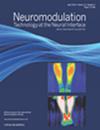外周神经刺激治疗疼痛:临床实践模式调查。
IF 3.2
3区 医学
Q2 CLINICAL NEUROLOGY
引用次数: 0
摘要
背景:与药物治疗相比,外周神经刺激(PNS)具有镇痛、改善功能和提高生活质量的潜力,因此近年来临床上对其的关注和使用显著增加。然而,由于 PNS 专用系统相对较新以及临床实践指导有限,PNS 的使用模式可能存在很大差异:我们试图开展一项调查研究,了解 PNS 特定临床实践的特点,并提出下一步标准化 PNS 使用关键实践的建议:我们在网上向疼痛科医生发放了一份包含 19 个问题的调查问卷,探讨与 PNS 相关的临床参数。结果:共收集到 94 份回复:结果:共收集到 94 份回复。在患者选择方面,大多数医师会使用 PNS 治疗主要关节骨关节炎引起的痛觉疼痛(77.7%)和慢性腰背痛(64.9%),但不会使用 PNS 治疗轴性颈痛(50.0%)。与此相反,大多数人会使用 PNS 治疗外周神经痛(94.7%)、颅周神经痛(77.7%)和癌症相关神经痛(64.9%)引起的神经病理性疼痛。在治疗复杂性区域疼痛综合征时,大多数医生会在所有其他形式的神经轴神经调控之前应用 PNS(每种形式的比例均大于 50%)。同样,在治疗非手术性腰背痛时,大多数医生会在神经轴神经调控(每种形式均大于 50%)之前应用 PNS,但不会在射频消融(19.2%)之前应用 PNS。大多数人在进行 PNS 之前会常规进行神经阻滞,主要是为了确认解剖学覆盖范围(84.0%),并将 50% 至 75% 的四分位数间范围视为进行 PNS 之前所需的最低镇痛效果。关于治疗腕部/手部或踝部/足部复杂区域疼痛综合征或膝关节骨关节炎的神经靶点选择,我们观察到 PNS 靶点位置和离散神经的差异非常大。关于 "轻微 "不良事件,大多数人表示在遇到皮肤/软组织反应(85.1%)、轻微感染(76.6%)或导线移位/功效丧失(50.0%)时不会改变 PNS 的使用。相比之下,大多数人在遇到皮肤侵蚀(58.5%)、严重感染(58.5%)或导线断裂(41.5%)时会减少使用 PNS:结论:在许多关键的临床考虑因素中,使用 PNS 的实践差异很大。结论:在许多关键的临床考虑因素中,PNS 的使用存在显著的实践差异。未来的研究若能探索造成这些差异的原因,可能有助于优化患者选择、目标选择、围手术期管理以及最终的结果。本文章由计算机程序翻译,如有差异,请以英文原文为准。
Peripheral Nerve Stimulation for Pain Management: A Survey of Clinical Practice Patterns
Background
Clinical interest in and utilization of peripheral nerve stimulation (PNS) for treating chronic pain has significantly increased in recent years owing to its potential for providing analgesia and improved function and quality of life in comparison with pharmacologic treatments. However, the relative infancy of PNS-specific systems and limited clinical practice guidance likely contribute to significant variation in PNS utilization patterns.
Objectives
We sought to conduct a survey study to characterize PNS-specific clinical practices and propose the next steps in standardizing key practices for PNS utilization.
Materials and Methods
A 19-question survey exploring PNS-relevant clinical parameters was disseminated online to pain physicians in practice. Descriptive statistics were used to summarize results.
Results
A total of 94 responses were collected. Regarding patient selection, most practitioners would apply PNS to treat nociceptive pain from major joint osteoarthritis (77.7%) and chronic low back pain (64.9%), but not for axial neck pain (50.0%). In contrast, most would apply PNS to treat neuropathic pain from peripheral neuralgia (94.7%), pericranial neuralgia (77.7%), and cancer-related neuropathic pain (64.9%). In treating complex regional pain syndrome, most practitioners would apply PNS before all other forms of neuraxial neuromodulation (>50% for each form). Similarly, for treating nonsurgical low back pain, most would apply PNS before neuraxial neuromodulation (>50% for each form) but not before radiofrequency ablation (19.2%). Most routinely performed nerve blocks before PNS, mainly to confirm anatomical coverage (84.0%), and regarded a 50% to 75% interquartile range as the minimum analgesic benefit required before proceeding with PNS. Regarding nerve target selection for treating complex regional pain syndrome of the wrist/hand or ankle/foot, or knee osteoarthritis, we observed a very wide variance of PNS target locations and discrete nerves. Regarding “minor” adverse events, most reported not changing PNS utilization on encountering skin/soft tissue reactions (85.1%), minor infections (76.6%), or lead migration/loss of efficacy (50.0%). In comparison, most reported reducing PNS utilization on encountering skin erosion (58.5%), major infections (58.5%), or lead fractures (41.5%).
Conclusions
There is significant practice variation regarding the utilization of PNS across numerous key clinical considerations. Future research that explores the reasons driving these differences might help optimize patient selection, target selection, periprocedural management, and ultimately outcomes.
求助全文
通过发布文献求助,成功后即可免费获取论文全文。
去求助
来源期刊

Neuromodulation
医学-临床神经学
CiteScore
6.40
自引率
3.60%
发文量
978
审稿时长
54 days
期刊介绍:
Neuromodulation: Technology at the Neural Interface is the preeminent journal in the area of neuromodulation, providing our readership with the state of the art clinical, translational, and basic science research in the field. For clinicians, engineers, scientists and members of the biotechnology industry alike, Neuromodulation provides timely and rigorously peer-reviewed articles on the technology, science, and clinical application of devices that interface with the nervous system to treat disease and improve function.
 求助内容:
求助内容: 应助结果提醒方式:
应助结果提醒方式:


